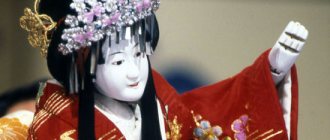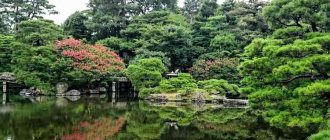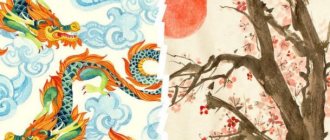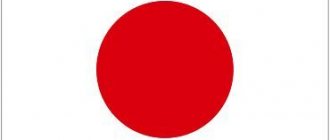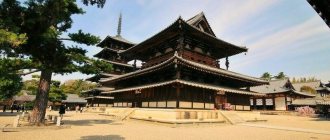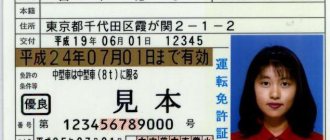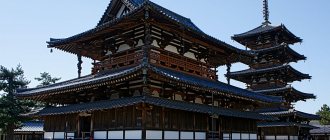The Land of the Rising Sun appears exotic and incomprehensible to travelers accustomed to Western standards of living. Literally everything here surprises - from the intricate language to the breathtaking landscapes, and all kinds of souvenirs are eye-popping. For those who are planning a trip to the mysterious Pacific island and are wondering what to bring from Japan as a gift, we have prepared a list of the most popular and unusual memorable gifts that reflect the uniqueness of this extraordinary region.
Maneki-neko
Walking along the streets of Japanese cities, you will probably notice Maneki-neko - good luck talismans, whose name is translated from Japanese as “beckoning cat”, displayed in the windows of shops and restaurants. Every detail of the funny figurine carries a meaning. Thus, a raised right paw promises success in business, while the left paw attracts interesting and profitable acquaintances. Seals with two limbs stretching upward are purchased to protect the hearth.
The color of the talisman also plays an important role:
- gold represents prosperity and wealth
- white means purity of thoughts and a positive attitude towards life
- black protects from evil spirits
- green brings health and helps in mastering new knowledge
- blue helps to find spiritual harmony
- red and pink promote success in love and friendship
Maneki-neko are sold everywhere, filling the shelves of all souvenir shops. The most sacred place for shopping is the Gotoku-ji Temple in Tokyo, where the cult of alluring cats began in the 17th century.
Order a private transfer from the airport to your hotel for RUB 17,638
Edible gifts
Of course, you are unlikely to be able to bring sushi and rolls from Japan, but there are several options for excellent edible souvenirs that you should pay attention to.
- Salty sakura. No kidding! In this country, people not only admire cherry blossoms, but also eat its fruits, leaves and flowers. The latter are salted and pickled in plum vinegar, resulting in pale pink inflorescences with a pronounced taste. Of course, such an unusual delicacy is not included in the daily diet of the Japanese, but is present only at significant events. For example, it is an indispensable attribute of wedding celebrations.
Packaging of salted sakura
Salted sakura flowers can be eaten as a treat on their own or used to decorate various dishes, such as baked goods or rice. Sometimes sakura needs to be pre-soaked in water, but to prepare original tea, simply dip 1-2 flowers into a cup of drink.
Dessert with salty sakura
- Umeboshi or salted plum has long been present in traditional Japanese menus along with rice and miso soup.
Umeboshi
Samurai also believed that umeboshi helped them fight fatigue on the battlefield and charged them with energy for future victories. This product contains a huge amount of nutrients, it helps control weight and is involved in the prevention of various diseases. However, due to its salty taste, umeboshi is not eaten daily, and is usually paired with rice without any other additives.
Rice with umeboshi
- Chocolate and candies with green tea. The Japanese are famous for their originality in preparing sweets. If you are partial to confectionery, you can try the matcha-infused sweets and baked goods here.
Matcha cookies
Pay attention to the brands Meiji, Morinaga and Lotte. They create truly amazingly delicious chocolate, caramel and green tea cookies. In Japan, you can even find matcha-flavored KitKat bars and Chocopie cakes.
Traditional clothes and shoes
The history of the national costume - kimono - goes back more than 1,500 years. Over the years, its appearance has not changed: as before, this item of clothing consists of four cloths (“tan”), which are belted with a wide sash (“obi”). The original outfit is sewn from expensive fabrics and hand-painted. The price of such masterpieces amounts to tens of thousands of yen.
You should not choose a classic kimono as a souvenir, because even Japanese women have difficulty putting it on. It would be better to buy a casual summer version of the yukata. It is sewn from inexpensive materials: linen, cotton or satin. Such a purchase is unlikely to empty your wallet. And finding a yukata will not be a problem: the popular attire is sold in all shopping centers and department stores.
It is absurd to wear traditional clothes with usual shoes, so it would be useful to purchase national shoes. But leave the original geta aside: you need to learn to wear bulky wooden sandals from early childhood. It would be much wiser to buy comfortable zori - a Japanese variation of flip-flops.
GIFTS FOR FRIENDS AND RELATIVES
Matcha or Matcha . Literally translated, “matcha” means “ground tea.” This is the type of green tea that is commonly used in the traditional Japanese tea ceremony. And what they do with it in modern Japanese cooking is just a guard for the champions of tradition! Green powder is added to cocktails, pastry cream, ice cream, rice cakes, cakes, and sprinkled on donuts! On the other hand, why not?
Matcha green tea is the main gastronomic souvenir from Japan. Many people bring it from Japan as medicine - this tea is so beneficial. You can buy matcha in almost every supermarket in the country. Prices for it are 2-3 times lower than in Russia.
Many tourists, having tried green powdered tea for the first time in Japan, bring it home with them. Why not an idea for a souvenir?
Sweets. You can bring sweets to friends from Japan that are not available in Russia: sweets based on black sugar, or even with the taste of burger, cabbage, lamb, bitter radish and other non-obvious products.
Yukata . Casual lightweight cotton kimono. Yukata are sold in all souvenir shops, but if you want a high-quality kimono, it is better to go to a regular clothing store - they have more choice and higher quality of the fabric used.
Food box . A bento is a ready-to-eat lunch box consisting of rice, fish or meat and vegetables. Bento boxes, made from lacquered wood, originated around 1600 and remain popular even today. Bentos have become popular all over the world and now a box made of varnished wood will become not only a pleasant souvenir, but also a useful item in the home.
Japanese knife . Another thing that will definitely serve you well in the kitchen is a traditional Japanese knife. There are two main types of knives - honyaki are made from one type of material (highly hardened steel), but kasumi are made from two types of metal, like real samurai swords. Don't forget that you can only carry them in your luggage.
Katanas. As a gift for men from Japan, you can bring a replica of a samurai sword (katana). They are miniature and very inexpensive - they are sold in almost every souvenir shop. If desired, you can also find a large sword with skillful engraving.
Cosmetics . Japanese skincare and decorative cosmetics are known all over the world. Local cosmetic products often include extracts of mint, jasmine, green tea, rice, beans, as well as water from thermal springs and horse oil. Cosmetics in Japan can be purchased either in pharmacies or in specialized departments in shopping centers. The most popular brands for face and body care are Shiseido, Rosette, Mujirushi and Kotoshina. Among decorative cosmetics, it is worth noting products from the brands Coffret D'or, KATE, MAQuillAGe and Canmake.
Japanese porcelain . There are about 18 types of Japanese porcelain, some of which are still produced using ancient techniques, others integrate modern technologies and reproduce Chinese counterparts. The choice is huge: it all depends on the purchase budget, design and size. A popular souvenir in this category is sake cups.
Jewelry . It is definitely worth bringing jewelry from Japan. Pearls are especially good: the best choice is at the Tasaki Gallery in Tokyo. Prices for designer jewelry in this store start from 60 thousand yen.
It is worth paying attention to jewelry. The one made from medical (jewelry) steel is especially good.
Vagasa
A traditional wagasa umbrella will help complete the exotic ensemble of yukata and zori. The birthplace of any self-respecting geisha's accessory is China. This exquisite item came to the Land of the Rising Sun in the 6th century. Initially, elegant folding umbrellas were the privilege of the elite, and only two centuries later they became widespread among the people.
The technique for creating vagas is not complicated, but it is labor-intensive. The bamboo parts are joined together with horsehair. A dome made of the thinnest paper is attached to the resulting frame, which is then painted and impregnated with oil. Wooden elements are varnished. As a result of these manipulations, a light and elegant, but at the same time durable and waterproof umbrella is born.
Today, only a few craftsmen in the country have the skills to make traditional bamboo frames. Therefore, if you decide to buy real wagasa, go to the city of Gifu, which is located 390 km from Tokyo. Since the mid-18th century, local craftsmen have been handcrafting exquisite products that are considered the standard of national umbrellas in Japan.
Sake
It would be a mistake to call the classic Japanese drink rice vodka or wine. The favorite alcohol of the samurai is an original product, the analogues of which cannot be found in any country in the world. Even the production of sake is unique: only premium varieties of rice are used for its production, which have undergone the mandatory grinding and steaming procedure.
Sake is an insidious drink. This rice elixir with a strength of 16% is surprisingly easy to drink: you can “persuad” more than one serving without noticing. However, the consequences in the form of wobbly legs and headaches will not take long to arrive. To prevent such an incident from happening to you, follow the unspoken rules for drinking the national potion: pour the drink into tiny bowls (2-3 sips), savor it slowly and do not neglect the appetizer.
When choosing alcohol, focus on its cost: the price of a good product starts at 2,000 yen. The hieroglyphs 清酒 on the label, meaning “natural sake,” will also tell you about the quality of the drink.
What can you buy cheap in Japan?
Japan is considered an expensive country.
First of all, this concerns its megacities. It would seem that the famous Japanese equipment should have a lower cost in its homeland, but even here the tourist will be disappointed. Prices are not too different from European ones, and when exported from the country, the possibility of full warranty service is lost. But everything changes dramatically as soon as the product sits for a couple of seasons. Models of previous years and their components can be purchased at great profit, since their place in the price niche has already been taken by expensive new items.
And there have long been legends and anecdotes about successful purchases of used products from the Japanese automobile industry by our compatriots, although the truly golden times for this business are already in the past.
Take note: it is better to exchange part of the necessary funds for local currency, especially if you plan to travel to the countryside.
Surprisingly, in one of the most high-tech countries, the attitude towards money is still more traditional than in Russia. Despite the abundance of ATMs, even in Tokyo you can’t pay with a bank card everywhere; for example, some restaurants only accept cash payments during the day, not to mention taxis and other small expenses.
You will definitely need information about what pleasant and profitable purchases you can make in Belarus.
Green tea
Japan is the birthplace of matcha, a bright emerald-colored drink made from powdered green tea leaves. The best raw materials for preparing matcha are grown in the vicinity of the city of Uji, where each store offers three varieties:
- Culinary, with an intense tart taste. Used for making baked goods, desserts and smoothies.
- Premium, distinguished by a slight bitterness. In Asia, tea from this variety is drunk pure, and in Europe it is sometimes diluted with a small amount of milk.
- Ceremonial, made from young spring leaves of the tea bush. This is the most expensive type, used for classical tea ceremonies and Buddhist rituals.
Regardless of the variety, matcha has a high concentration of caffeine, antioxidants (polyphenols) and the amino acid L-theanine, which is responsible for the production of the “happiness hormone” dopamine. According to research, drinking a traditional drink will not only improve immunity, speed up metabolism, remove toxins and strengthen the circulatory system, but also help in the fight against stress, and also invigorate better than coffee!
Sweets
Local delicacies are an ideal gift for those with a sweet tooth. Many of you are probably familiar with KitKat candies, but in the Land of the Rising Sun alone you can find about 250 types of these popular filled candy bars. Tasting them is like eating Bertie Botts beans: Nestlé's Japanese factories produce candies with unimaginable flavors of green tea, sakura, fried potatoes, pepper, wasabi, pickled plums or soy sauce.
Wagashi also belongs to the category of exotic desserts. To create this classic of the country's confectionery art, which differs from European candies in its less sweet taste, natural ingredients are used: chestnuts, agar-agar, herbs, rice, tea, sweet potatoes and legumes.
Lovers of sweet pastries should take a closer look at dorayaki or taiyaki pancakes - fish-shaped cookies filled with custard or chocolate. And fans of healthy eating will be attracted by amanatto - candies that are nuts dressed in a “coat” of bean paste.
Bell Furin
Total industrialization and advanced technologies coexist perfectly with deep reverence for the beliefs and traditions of our ancestors. Here, special significance is attached to talismans called omamori. One of these amulets is the Furin bell, whose melodious ringing is designed to protect houses and their inhabitants from negative energy and evil spirits.
Traditionally, furins are made from glass, ceramics, metal and bamboo. A rectangular piece of paper is attached to the tongue, on which wishes or haiku tercets are written. To prevent adversity from happening at home, the Japanese decorate the windows and cornices of their homes with bells. In the summer heat, gentle chimes, associated with a fresh wind and a babbling brook, create an aura of coolness and comfort.
Every year, in the second half of July, the surroundings of the Kawasaki Daishi Shrine (8 km from Tokyo) are filled with the sound of more than 600 bells of various shapes and sizes. Melodious polyphony marks the opening of the popular Furin festival, attracting thousands of tourists and locals.
What can and cannot be exported from Japan?
The island country's customs have strictly enforced rules. You can transport both national and foreign currency of any type. Amounts from 1 million government yen and their equivalents in foreign banknotes are required to be included in the declaration. You can take no more than 56 milliliters of perfume with you on a plane. Most goods are limited in value to 200 thousand Japanese yen for export.
strictly prohibited to transport artistic and antique objects, cultural values without official permits from control authorities. The ban applies to pornographic items and publications, weapons, explosives, psychotropic drugs and substances with a narcotic effect. You will not be allowed to take with you anything that violates patent restrictions and copyrights.
Fan
A fan decorated with an intricate pattern would be a good gift for the fair sex. This constant companion of geishas and Kabuki theater actors appeared in the country in the 12th century. The first fans (utiva) were a non-folding structure made of a skillfully turned piece of wood covered with silk.
Fans are not just a lady's privilege. The ogi, a folding fan with a small number of ribs, was considered an exclusively male attribute, used in court ceremonies and indicating the rank of its owner. The combat gunsen, made of wood and metal, stands apart. Such a fan was a full-fledged weapon, with the help of which warriors attacked, defended and distracted the enemy’s attention.
Traditional fans are made by hand using bamboo and special multi-layer paper. And today, for the Japanese, fans are more than just an escape from the heat and an element of national costume. These accessories are used to decorate walls in houses, they are collected, given to loved ones and used in marriage ceremonies.
What unusual things to buy in Japan
In blogs and travel programs, Japan is often presented as an amazing land full of wonders and oddities.
Even ordinary food is quite specific. For example, local desserts may not seem sweet at all, and some traditional dishes will even disgust an unaccustomed European.
Please note: anyone who wants to purchase a real samurai sword will have to give up this dream - katanas in Japan are both a weapon and a work of art, so their export is prohibited. However, you can buy replicas of these swords, not real weapons.
Few of the fair sex can resist Japanese costume jewelry and jewelry. Famous pearl farms are located here. Such products are not cheap, but, compared to the laconic European tradition, the Japanese assortment often looks more varied and interesting.
Masks
One of the greatest traditions of world theater is the Japanese Noh theater. Wooden stages that amaze with the deep meaning of the performances, minimalist music and grandiose costumes - all this has reached contemporaries almost unchanged since the 14th century - the era when the Zeami father and son created a new art direction. Masks, a mandatory attribute of actors’ equipment, have not changed either.
The actors of the No theater do not resort to facial expressions and makeup. To express feelings and emotions, they wear masks made from cypress. Each theater carefully preserves a collection of 150–200 masks. They are divided into male (otoko-men), female (onna-men), and also differ in appearance, character and age.
Today, “No” masks have become widespread as popular wall decorations. In souvenir shops you can purchase full-size wooden copies or smaller copies made of ceramics, inserted into exquisite frames.
Food sticks
If you don't have much room left in your luggage for gifts, buy hashi - Japanese chopsticks, which differ from Chinese chopsticks in their shorter length and rounded shape. In the Land of the Rising Sun you will find many stores specializing only in the sale of this accessory. The range is huge: from the simplest disposable ones to patterned and varnished wooden masterpieces.
The Japanese use traditional cutlery for more than just tasting rice or noodles. Chopsticks are used to wrap sushi, pick out bones, cut fish, and stir soups and sauces. Khasis are an extremely personal item; sharing them even with close people is considered a bad omen.
Chopsticks are a multifunctional souvenir. They are given not only to fans of Asian cuisine. According to legend, Khashis promise longevity and good luck to their owner. Sticks painted with oriental patterns can also be presented to newlyweds with the wish to be inseparable like a hashi couple.
What equipment to buy in Japan
Many people go to this country for its unique electronics.
Despite the fact that difficulties with warranty service may arise outside the country, people confidently buy cameras, household appliances and various technical items in Japan.
And all because it is profitable - rarely of these purchases will require warranty repairs, because there is little that can compare with Japanese production quality.
When answering the question of what to buy in electronics in Japan, you should keep in mind that there are several nuances associated with local devices and appliances:
- In most regular stores you can only buy models with a Japanese interface. Reflashing it will cost a pretty penny, so for international options you need to go to duty free.
- Japanese mobile phones will also give a head start to any Chinese-assembled unit, however, alas, they are completely useless in Russia. In addition to specific input, their disadvantage is that they are blocked from working with a specific cellular operator.
Bento lunch boxes
The term "bento" refers to food packaged in a beautiful container. In your local stores you will find hundreds of variations of this useful accessory. There is a wide choice: from simple plastic boxes to airtight lunchboxes equipped with a cooling element or oval wappa bento with antibacterial properties.
The bento culture in the country is extremely developed. There are special books dedicated to the art of harmoniously composing a “take-out lunch”. Culinary magazines never tire of publishing tips on how to properly combine foods to prepare a balanced and healthy lunch. Here are just a few of them:
- Avoid processed foods
- Each serving should include carbohydrates (rice, noodles), protein (meat, fish) and vegetables
- Food must be cut into pieces and heated evenly
Those who do not want to prepare bento themselves buy lunch boxes in supermarkets. The average price is about 542 yen ($5).
Kokeshi
The attitude towards dolls is special. From time immemorial, local residents believed that each of the figurines had unique properties. They were considered the guardians of the hearth, valued and passed on by inheritance. One of these amulet dolls is kokeshi - a figurine devoid of arms and legs with a cylindrical body and a large head.
The history of kokeshi began in 1603 on the island of Honshu. Kijiya carpenters from the Tohoku region, who made their living by making tableware, invented a new source of income. They began carving cute figures out of wood, hand painting them, and then selling them as talismans to wealthy gentlemen relaxing at nearby hot springs.
Today, dolls are turned on a lathe. The figurines cannot boast of a wealth of colors and patterns: the decorative elements are extremely modest, and the palette of shades is limited to red, yellow, black and green. However, this does not prevent kokeshi from being a desired gift. Dolls are given as a sign of love, sympathy and sincere friendship. It is believed that such a gift brings prosperity, good luck in business and harmony in the soul.
TRADITIONAL CULTURE
Khasi. Food sticks . Of course, they eat with chopsticks not only in Japan, but also in China, Vietnam, and Korea. And they are different everywhere! In Japan they are called hashi. Dishes are prepared in small pieces, and soups are served in bowls: the liquid is drunk, the thickness is removed with chopsticks. Children receive hashi on the hundredth day after birth along with their first grain of rice.
In household use, reusable sticks made of wood, bone, plastic, richly inlaid, are real works of art. There are children's, men's, women's khasis, sets for spouses and for the whole family, gift sets for newlyweds. Khasi for the tea ceremony, for sweets, just for cooking...
Wagasa paper umbrella . This is another symbol of Japan. No one knows how old this elegant accessory is. The court lady Sei-Syonagon, the author of “Notes at the Headboard” and a contemporary of the Kyiv prince Vladimir, wrote that an umbrella is a necessary thing in every wealthy family. Over two thousand years, vagasa gradually moved from a luxury item to a common accessory, and in the twentieth century they were replaced by modern umbrellas. But the Japanese do not want to completely abandon traditions.
Paper umbrellas are still used by geisha and maiko. Girls flaunt small wagasa at traditional holidays. Large umbrellas are raised over newlyweds during ceremonies at Shinto shrines. Even a sumo wrestler can be seen with a wagasa in his hands. And for tourists, a paper umbrella is a wonderful souvenir from Japan.
Glass bell "furin" . Furin, with its soft chime, can bring coolness even on the hottest day, so all of Japan sounds like this in the summer. Glass trinkets were brought from China about two thousand years ago. In Buddhist temples, bells warded off evil spirits, and pleasant shimmers delighted the ears.
Japanese fan . During the summer, on Japanese streets, on trains and in restaurants, you can see many people using hand fans. They can be folding or rigid flat fans. Hand fans are so popular in Japan that it is simply impossible to leave Japan without taking at least one with you.
Paper lanterns . They are made from Japanese washi rice paper, which is attached to a bamboo frame. This is a traditional way of illumination in Japan and can be found everywhere - at festivals, in parks, restaurants or hotels, as well as in residential buildings.
Sarubobo dolls. They come from Takayama City, Gifu Prefecture, and protect against evil, bring harmony to the family, and help women in labor. In such dolls, facial features are usually not drawn.
Kokeshi dolls . Another wonderful souvenir that you can bring home to remember your trip to Japan. These wooden dolls are said to bring good luck. The kokeshi facial expressions indicate the region where the doll was made. Initially, these were children's toys, but now they are increasingly becoming home decoration or souvenirs for tourists.
Maneki-neko. Perhaps the most famous symbol of Japan is a figurine of a cat with a raised paw. Everywhere in Japan, from shops and restaurants to banks and offices, you are greeted by a “luring cat” statue. This maneki neko is one of the most famous good luck charms in Japan and is believed to bring good luck to business and increase wealth.
They are also used to decorate the interior of the house, since cats can be made in any size and from any material. You can buy them in a souvenir shop, but it is best to do this at Gotoku-ji Temple, the birthplace of this talisman.
Daruma. A papier-mâché doll sold with white eyes. The toy is usually red, although there are also green, yellow, blue, white... There are no arms or legs, just a mustache. There are no pupils either. First, one eye is drawn on the doll and a wish is made. Until Daruma-san fulfills it, he will not receive a second eye. Well, if he didn’t manage it, he ended up in the January bonfire where holiday trees are burned! And rather buy yourself a new daruma.
Gamaguchi. Rag handbags and wallets with frame lock. Their colors are quite bright and most often floral. These pieces have a bit of a vintage feel to them because similar clasps were found on vintage coin purses. But, despite the seeming old-fashionedness, gamaguchi are very popular among young Japanese women.
Porcelain
Interest in porcelain products arose in the country in the 14th century thanks to trade with China. At that time, exquisite fragile things were the privilege of the powerful: the emperor and his entourage. The country's own porcelain industry began to develop two centuries later, after the discovery of kaolin deposits on the island of Kyushu.
The art of creating porcelain has been brought to perfection. Elegant figurines and sophisticated dishes are resistant to chips, do not absorb odors, and withstand both high and low temperatures. The products are characterized by laconic design, modestly expressed relief and numerous small details with clear lines. The painting is either extremely minimalistic and unobtrusive, or full of images of flowers, birds and fairy-tale creatures.
Today, the most famous brands are Japonica, Nikko, Keito, Narumi and Noritake. To avoid purchasing a fake, pay attention to the marking when purchasing: original products bear the stamp “Fine Bone China,” which means “fine bone china.”
Tenugui
The Japanese desire for cleanliness is known throughout the world. Residents of the Pacific island never cross the threshold of the house in street shoes, and in all restaurants and cafes, visitors are first served hand towels - tenugui. These 30x90 cm decorated cotton products have a long history, first appearing during the Kofun period (250–538).
Tenugui are amazingly versatile. You can use them to tie your head, wipe your hands, blot up spilled tea, or place them on your lap when you need to clean fruits dripping with juice. But remember: while in Japan, never try to use a tenugui as a handkerchief - any local resident will consider this act to be savage.
If you are looking for packaging for a memorable present, feel free to buy tenugui too. By the way, sellers in many stores are fluent in the technique of folding national towels into dozens of different shapes, forcing the souvenir to play with new colors.
Kairo
Winter in Japan can be quite cold. It’s no wonder that the world’s largest festival of snow and ice sculptures takes place here. But inventive locals found a way to stay warm on frosty days: they came up with kairo. These are dry heating pads, which are small bags with powder inside. They are sold in individual packages and are disposable.
Kairo - a warm souvenir from Japan
They are very easy to use: you just need to take the Kairo out of the package, place it in your pocket or attach it to your clothes, and the powder will begin to act in just 10 minutes. The warming effect lasts from 8 to 15 hours. This souvenir will greatly delight your friends who do not like the winter season.
Samurai sword
It's hard to imagine a better souvenir for a man than a samurai sword. The weapon, mesmerizing in its shape, is the spiritual symbol of the Land of the Rising Sun, personifying courage, valor and the highest justice. Buddhists perceive this unchanging regalia of ancient warriors as the embodiment of strength, wisdom and divine purity.
The first sword (katana) appeared in Japan at the beginning of the 13th century. Soon, steel blades were canonized, and the craftsmen who made them received high social status. According to archival data, from ancient times to the mid-20th century, only about 2 million swords were produced in the country. Each copy was truly priceless and was passed on by warriors from generation to generation.
Today, authentic samurai swords have enormous historical and cultural significance; the value of the relics is tens of millions of yen. However, in stores you can find good replicas: from souvenir miniatures to full-size copies of katanas, made based on the creations of the best weapons makers of the Middle Ages.
What to buy in Japan from cosmetics
Japanese skin and hair care products need no introduction.
At one time, Shiseido and Biore products made a real splash on the Russian market. But this is just the tip of a huge cosmetic iceberg.
In addition to them, it is worth taking a closer look at the brands FANCL, Shu Uemura and Cle de peau. Local residents place the main emphasis on cleansing the skin and protecting it from exposure to sunlight. The most powerful sanitary units and a thorough multi-level cleaning system are about Japanese care.
If you are thinking about what to bring from Japan as a gift, then you can recommend the famous fashion house Kenzo and its products, which are traditionally associated with Japan. Some tourists even try to find official stores of this brand in Tokyo.
This is interesting: in fact, the Kenzo brand is based in Paris, the capital of fashion and perfume, and owes its name and aesthetics to the founder Takada Kenzo. He was indeed born in Japan, but transferred its spirit to the fertile soil of Europe back in 1970.
Ukiyo-e prints
In the 17th century, a new art direction, Ukiyo-e, appeared. This style refers to woodcut, which means an impression on paper or printed graphics on wooden surfaces. Ukiyo-e were not works of painting: rectangular prints were viewed as mass media and cheap pictures for ordinary people.
Initially, artists used black and white ink to create Ukiyo-e, and only a century later the pictures acquired color. Since the main buyers of the prints were ordinary townspeople, the subjects of the images reflected everyday life: beautiful geishas, monumental sumo wrestlers, Kabuki theater actors. Later Fukei-ga (landscapes), Kate-ga (birds, flowers) and Shunga (canvases of erotic content) appeared.
The art of Ukiyo-e is still popular today. Modern masters apply images not only to engravings. Copies of famous paintings of the past are placed on clothes, dishes, handbags, tenugui, fans and postcards.
Turner paints
If your friend spends all his free time at an easel, he will probably be happy with Turner paints. Japanese acrylic gouache, named after the English painter William Turner, applies evenly, dries quickly, does not crumble and has good water resistance. Adhesion is also excellent: the paint “sticks” remarkably well to any grease-free surface, so not only paper, but also plastic, fabric, leather, metals, ceramics, wood, and stone can serve as a canvas.
Acrylic gouache is available in 221 shades, including velvety pastels, exotic fluorescents, shiny metallics and pearls glowing from within. All colors mix perfectly without conflicting with each other.
An artist who prefers more delicate and transparent textures will enjoy professional watercolors. To produce the 148 shades included in the palette, Turner experts select pigments that are long-lasting and bright without a hint of haze. Thanks to them, the completed work will delight the creator for a long time with natural and impressive shades that are not in danger of quickly fading.
Music Box
When choosing a gift for friends who know a lot about Asian melodies, pay attention to the traditional music boxes that were born more than a century ago in the vicinity of the now popular resort of Hakone. These regions have long been famous for the variety of wood species, and local craftsmen are known for their ability to create real works of art.
The Japanese box is a unique phenomenon. Its shape, size and pattern depend only on the author’s imagination. There are no generally accepted standards: on store shelves you will find square, rectangular, and round products, the lids of which are often painted using the artistic aizu-nuri technique or decorated with yosegi mosaics. Inside the musical representatives of the glorious family of decorative caskets lies a mechanism capable of playing up to 25 melodies.
Each box has its own secret. Opening it means solving a difficult puzzle. To lift the stubborn lid, you need to find a cleverly hidden lever or move the moving parts of the recalcitrant “puzzle” in a certain sequence.
Souvenirs
In Tokyo, it is convenient to buy souvenirs for friends in FixPrice format stores (all for 100 yen). These are not our “fixes” - here you can find things with a national character of very decent quality. Excellent shopping awaits you in the capital's Grandberry Mall - there is a large selection of souvenirs.
There are souvenir shops near Mount Fuji, so you can bring back something as a souvenir from here too. On the island of Okinawa, the best souvenirs are sold in Naha city on Kokusai Street.
Ceramics
The best ceramics in Japan are made on the island of Honshu: in Tokyo, Yokohama, Osaka, Kyoto, Hiroshima and other cities. The widest choice is perhaps in the city of Nagoya (located between Tokyo and Kyoto). Bring Ryukyu pottery from Okinawa - it is different from what is sold in the rest of Japan.
Varnish
Lacquerware from Nagoya is considered the best, but you can buy it in other places. The most popular products are boxes, dishes, sushi sets, vases.
From Okinawa, we recommend bringing a traditional hexagon-shaped lacquered plate, in which snacks are usually served. Lacquered sushi sticks cost an average of 400-500 yen, boxes - from 600.
Glass and porcelain
If you're in Okinawa, pay attention to Ryuk glass. It is most profitable to buy it in a store (by the way, there are many reviews about it from tourists from all over the world, which confirm our words)
Japanese porcelain is much younger than its counterpart from China, but today it is indeed very popular. The best souvenir in this category is sake glasses.
Textile
Towels and other home textiles made using the tenugui technique are an excellent purchase to remember your trip to Japan. The piece of fabric is made of cotton and decorated with a beautiful printed design. Reminiscent of traditional batik from Indonesia, but looks even more interesting. The best shopping in this category awaits you in Japanese markets (prices are higher in souvenir shops).
Knives
Japanese kitchen knives are quite expensive, but they are considered the best in the world for a reason. If you know a chef, bring him such a gift. Or buy a knife in Japan for yourself - it will serve you for a lifetime. Don't forget that you can only carry them in your luggage.
As a gift for men from Japan, you can bring a replica of a samurai sword (katana). They are miniature and very inexpensive - they are sold in almost every souvenir shop. If desired, you can also find a large sword with skillful engraving.
Art
Bring a fan from Japan with a beautiful painting on it: a landscape or an image of sakura. You can also buy a panel with hieroglyphs - it looks very beautiful and colorful. For calligraphy, you can go to the markets. There are also many street artists in Japan, whose works can be bought as an unusual souvenir.
Amulets, figurines
Figurines of samurai and geisha are often brought from Japan. Traditional Japanese Kokeshi dolls (with a small body, no arms and a large head) are also very popular among tourists. They are often made by hand, so the souvenir is not budget-friendly.
As a gift to your friends, bring an amulet to attract good luck and money - Maneki Neko. This is a cat with its paw up, which you will often see not only in souvenir shops in Japan, but generally throughout the country.
A figurine of a protective creature called Shisa is often brought from Okinawa. Furina wind chimes are also very popular throughout the country. Bring it from Japan as a souvenir - it won't take up much space and will cost you only 300-500 yen.
For teenagers
Fans of anime and manga can bring comics, books, CDs or posters from Japan that cannot be found in Russia. The country has a huge selection of clothing, jewelry and all kinds of accessories on this theme.
An excellent gift from Japan for a schoolchild could be one of hundreds of puzzles or a shogi (mahjong) board game. However, adults will also like them.
For children
Bring toys to children from Japan. The choice here is so large that even the most capricious child will be happy. Soft toys, dolls, cars, radio-controlled, robotic - you name it. Prices in Japan are reasonable: you can buy a children's car that you can ride in for about three times cheaper than in Russia.
You can buy toys in regular shopping centers. The largest selection is perhaps in the stores in the Akihabara area in Tokyo.
And if you want to buy something special as a souvenir, take a toy koma - it’s something between a spinning top and a top. Sold in souvenir shops and markets, often hand-painted.
Cosmetics
The velvety snow-white skin of Japanese women is the envy of many European women. The secret of the beauty of Asian enchantresses lies not only in good genetics and proper nutrition. Residents of the Land of the Rising Sun pay great attention to the choice of skin care products, among which the first place belongs to whitening and moisturizing products.
Toners, masks, emulsions and creams containing natural ingredients and designed to give the skin a delightful porcelain matte finish are leaders in the Japanese cosmetics market. The most famous manufacturers are Kanebo, Suhada, Yokota Lab, Shiseido, SK-II, Biore. Among decorative products, it is worth noting the products of the brands Isehan, Shu Uemura, Celvoke.
You can purchase cosmetics in specialized departments of shopping centers or pharmacies. You will find the most affordable prices for mass market goods in the chain stores Matsumoto Kiyoshi, Daiso or CanDo. Luxury brands are found only in fashionable department stores.
Where is the best place to buy souvenirs?
Connoisseurs of photographic equipment should go to the specialized area around Shinjuku Station . Both new and discounted copies are sold there. They are definitely cheaper than similar models in our country. Tokyo's main shopping district is Ginza . EVERYTHING is sold here. You can also buy used equipment in the Akihabara .
You need to look for the fish market on Tsukiy Street . More souvenirs are sold on Nakamise Street . It doesn’t make much sense to look for a specific store or shop. Japanese tradition predetermines the concentration of homogeneous establishments in certain areas. Omote-sando Street from Shibuya offers a similar selection to Ginza. However, the cost of goods has been significantly reduced. The Harajuku quarter , which this street abuts, contains clothing in a non-standard punk style.
In Osaka, we advise you to first go to the World Trade Center , which occupies the second largest Japanese skyscraper.
Ginza district in Tokyo
Cost of travel to Japan
